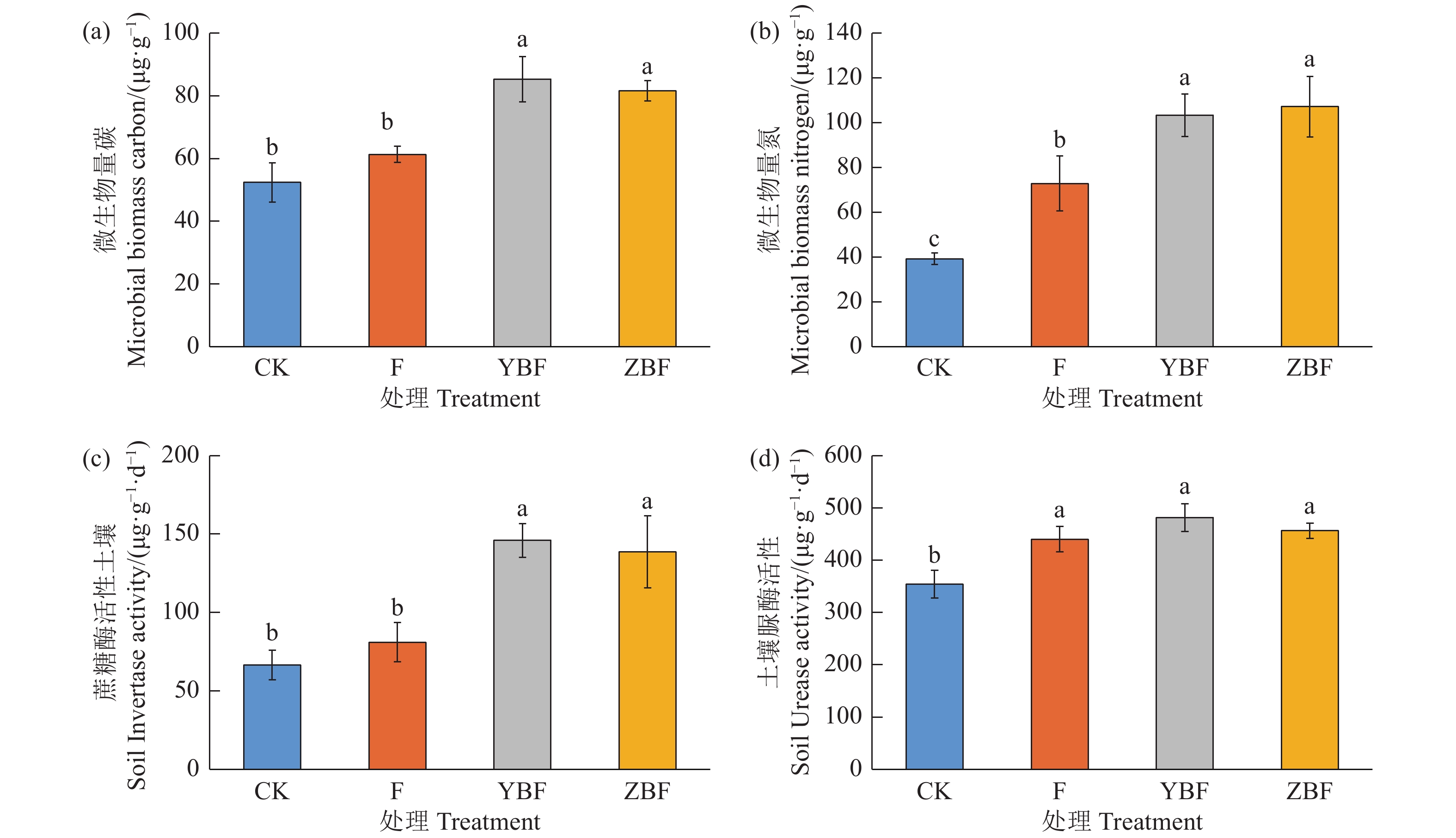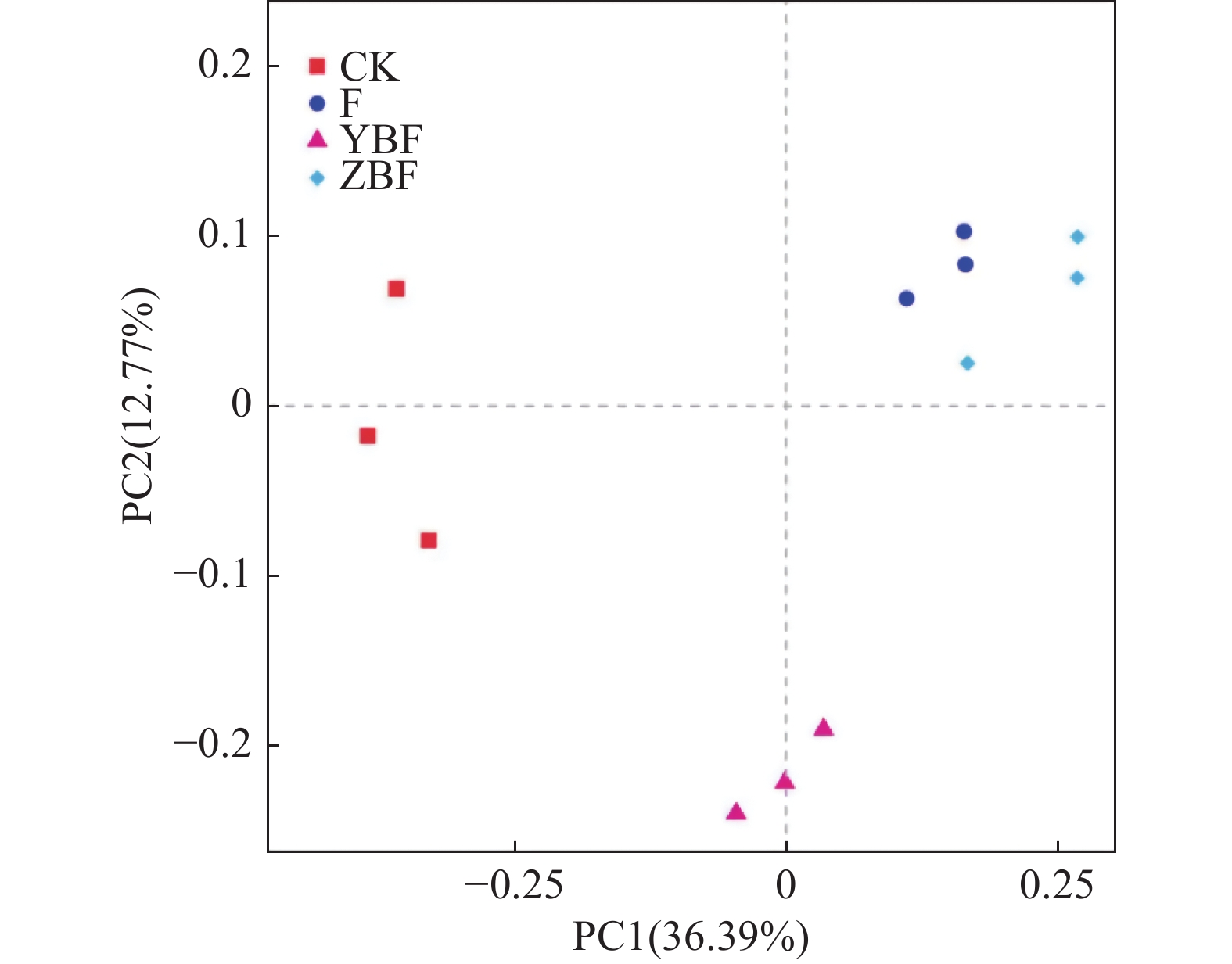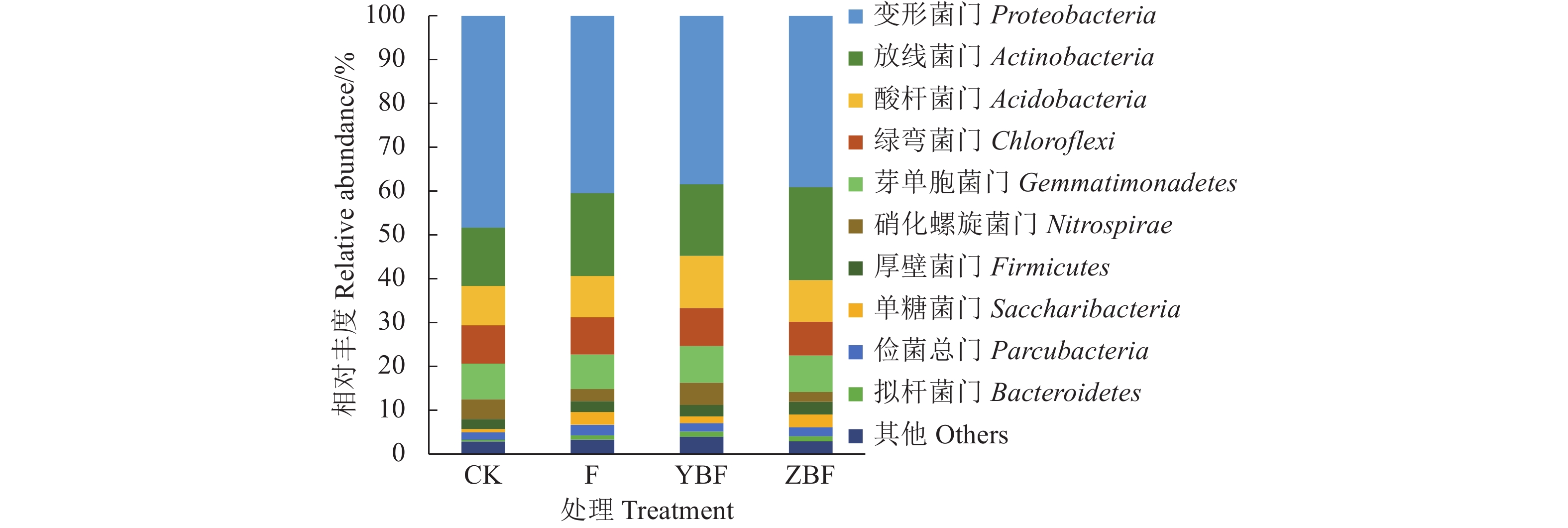Effects of Tobacco Stalk Biochar- and Bamboo Biochar-based Fertilizers on Carbon, Nitrogen, and Microbes in Soil of Tobacco Field
-
摘要:目的 通过大田试验,研究烟秆和竹炭基肥施用对植烟土壤碳氮组分及微生物的影响,为提升植烟土壤质量提供依据。方法 设置不施肥、烟草专用肥、烟秆炭基肥及竹炭基肥4个处理,研究烟秆与竹炭基肥施用后植烟土壤pH、碳、氮组分变化规律及其对酶活性、微生物群落的影响。结果 与烟草专用肥处理相比,施用烟秆炭基肥和竹炭基肥,土壤pH均提高0.5个单位以上,可溶性有机碳含量分别提高21.4%和30.7%,易氧化有机碳含量分别提高32.4%和17.9%,可溶性有机氮含量分别提高50.7%和37.7%,颗粒有机氮含量分别提高28.0%和12.7%,土壤蔗糖酶活性分别提高9.4%和3.6%,微生物量碳含量均提高30%以上。烟秆炭基肥处理土壤细菌群落Chao1指数与烟草专用肥处理和竹炭基肥处理相比分别显著提高5.4%和3.2%,而三者间的土壤细菌群落Observed species和Shannon指数无显著差异。烟秆和竹炭基肥处理均影响土壤细菌群落组成结构,变形菌门与不施肥处理相比分别下降5.0%和3.4%。与烟草专用肥处理相比,竹炭基肥处理厚壁菌门丰度提高18.3%,烟秆炭基肥处理玫瑰弯菌属丰度提升64.8%。结论 烟秆炭基肥及竹炭基肥均可提高土壤碳、氮组分含量,土壤酶活性和微生物群落丰度,进而优化土壤细菌群落结构。与竹炭基肥相比,烟秆炭基肥对改善土壤环境的效果更为明显。Abstract:Objective Effects of applying tobacco stalk biochar- or bamboo biochar-based fertilizer on the carbon, nitrogen, and microorganisms in soil of tobacco-growing fields were compared.Method In a field experimentation, treatments using no fertilizer as control (CK), a fertilizer designed for tobacco farming (TF), a tobacco stalk biochar-based fertilizer (TBF), or a bamboo biochar-based fertilizer (BBF) were conducted. pH, carbon, nitrogen, enzyme activity, and microbial community of the soil samples were monitored.Result Compared to TF, either TBF or BBF raised by more than 0.5 on soil pH and on microbial biomass carbon by more than 30%; on soluble organic carbon, TBF did by 21.4% and BBF by 30.7%; on oxidizable organic carbon, TBF did by 32.4% and BBF by 17.9% (p<0.05); on soluble organic nitrogen, TBF did by 50.7% and BBF by 37.7%; on particulate organic nitrogen, TBF did by 28.0% and BBF by 12.7%; and on invertase activity, TBF did by 9.4% and BBF by 3.6%. The Chao1 index of the microbial community in the TBF-treated soil was significantly higher than that of TF-treated counterpart by 5.4% and that of BBF-treated soil by 3.2%. However, there were no significant differences on the observed species or Shannon index of the microbial communities in soils under different treatments. Both TBF and BBF significantly affected the structure of the microbial community in the soil. Notably, the Proteobacteria population decreased by 5.0% under TBF treatment and by 3.4% under BBF treatment in comparison to CK. Even when TF was applied, BBF still managed to generate 18.3% greater abundance on Firmicutes, while TBF 64.8% on Curvularia, in the soil.Conclusion Either TBF or BBF treatment could increase the content of carbon, nitrogen, enzyme activity, and microbial abundance in the tobacco field soil. It helped optimize the structure of the microbial community as well. However, TBF seemed to benefit the improvements more than BBF did.
-
0. 引言
【研究意义】商品猪的生长发育均呈一定的规律性,前期骨骼、肌肉组织生长,后期脂肪组织沉积[1]。当前规模集约化养猪生产普遍采用“三阶段”生长育肥法,即小猪20~50 kg、中猪50~80 kg、大猪80 kg至出栏。“三阶段”生长育肥法虽然操作简便,但由于饲养阶段少,造成同一饲养阶段前期营养不足,后期营养供大于求。有研究证明,猪没有能力调节蛋白质摄取量来满足自身营养需求[2],“三阶段”生长育肥法不仅导致蛋白质等营养物质的浪费,且营养素的不平衡势必降低商品猪的增重和饲料利用率,商品猪饲料转化效率的下降直接关系猪场的养殖成本,并增加环境污染[3],传统的“三阶段”育肥法及其营养供给模式已不能适应精细化养猪生产的需要。【前人研究进展】乔建国等[4]、董志岩等[5]分别开展了“四阶段”和“五阶段”育肥法与“三阶段”育肥法的对比试验,并已证明在生产性能和饲料成本方面,“四阶段”和“五阶段”育肥法明显优于“三阶段”育肥法,主要原因在于猪的营养供给更加精准,饲料转化效率更高。在降低污染物排放方面,有资料报道,欧洲养猪发达国家普遍采用多阶段饲养法,生长肥育猪平均每头日增重增加40~50 g,粪尿排出量减少7%~20%,减轻了对环境的污染[6]。Han等[7]研究表明,相对于单一阶段饲养法,采用三、四阶段饲养法使猪粪氮减少约12%。【本研究切入点】国内关于不同阶段育肥法对生长肥育猪生长性能、胴体品质和肉品质影响方面已有研究[4-5],而在多阶段育肥法对生长肥育猪粪氮、磷排放量影响方面的研究鲜有报道。因此,在养猪与环境污染问题日益突出之际,有必要探讨商品猪不同育肥模式对氮、磷排放量的影响,为精细化养猪生产提供技术支持。【拟解决的关键问题】本研究通过比较分析“三阶段”和“五阶段”育肥法对生长肥育猪表观消化率及粪氮磷排放量的影响,为发展生猪生态养殖提供参考依据。
1. 材料与方法
1.1 试验设计
采用单因子对比饲养试验,试验分成2组(对照组和试验组),每组6个重复。对照组为“三阶段”育肥法及其营养供给模式,3个阶段分别为:20~50、50~80、80~120 kg;试验组为“五阶段”育肥法及其营养供给模式,5个阶段分别为:20~35、35~55、55~75、75~95、95~120 kg。
1.2 试验猪的选择、分组与管理
选择遗传相近、日龄为(63±3)d、平均初始体重为(19.5±1.6) kg杜长大三元杂交阉公猪72头,按体重相近的原则随机分为2组,每组6个重复(栏),每个重复6头猪。预试期6 d,试验期127 d。试验猪舍每个栏圈面积约10 m2,水泥地面,南北卷帘装置。试验猪日饲喂3次,每次投料以料槽内略有余料为准,自由采食,自由饮水。饲养试验于2018年3月在福建优康种猪发展有限公司猪场进行。
1.3 试验饲粮
试验饲粮为玉米-豆粕型,参照NRC(1998)[8]猪的饲养标准配制,饲粮组成与营养水平见表 1。
表 1 饲粮组成与营养水平Table 1. Nutritional composition of forages三阶段育肥Three-stage growing-finishing method/kg 20~50 50~80 80~120 五阶段育肥Five-stage growing-finishing method/kg 20~35 35~55 55~75 75~95 95~120 饲粮组成Compose of diet 玉米Corn/% 70.00 70.00 70.00 70.00 70.00 豆粕Soybean meal/% 23.00 20.00 18.50 14.50 11.00 麦皮Wheat bran/% 3.00 6.00 7.50 11.50 15.00 78.0% L-赖氨酸盐酸盐78.0% L-Lys·HCl/% 0.29 0.29 0.28 0.23 0.21 99.0% DL-蛋氨酸99.0% DL-Met/% 0.12 0.10 0.09 0.04 98.5% L-苏氨酸98.5% L-Thr/% 0.04 0.08 0.07 0.04 0.02 磷酸氢钙CaHPO4 /% 1.01 0.65 0.30 石粉Limestone/% 1.21 1.30 1.40 1.34 1.23 50%氯化胆碱50% Choline chloride/% 0.10 0.10 0.09 0.07 0.07 食盐NaCl/% 0.40 0.40 0.40 0.40 0.40 沸石粉Zeolite powder/% 0.33 0.58 0.87 1.38 1.57 预混料Premix①/% 0.50 0.50 0.50 0.50 0.50 合计Total 100.00 100.00 100.00 100.00 100.00 营养水平/%② 消化能DE/(MJ·kg-1) 13.39 13.31 13.22 13.06 12.89 粗蛋白质CP/% 16.16 15.23 14.68 13.66 12.67 赖氨酸Lys/% 1.02 0.96 0.92 0.80 0.70 可消化赖氨酸Digestible lysine/% 0.93 0.86 0.82 0.70 0.61 可消化蛋氨酸Digestible methionine/% 0.34 0.31 0.29 0.23 0.23 可消化蛋氨酸+可消化胱氨酸Digestible methionine+Digestible cystine/% 0.56 0.52 0.49 0.42 0.38 可消化苏氨酸Digestible threonine/% 0.60 0.56 0.53 0.46 0.40 可消化色氨酸Digestible tryptophan/% 0.19 0.17 0.16 0.14 0.12 钙Ca/% 0.75 0.70 0.65 0.54 0.50 总磷TP/% 0.53 0.48 0.42 0.38 0.30 注:①0.50%预混料向每kg饲粮添加:小猪:VA 8 000 IU,VD3 2 000 IU,VE 35.00 mg,VK3 2.60 mg,VB1 2.60 mg,VB2 8.50 mg,VB6 2.60 mg,VB12 0.03 mg,烟酸28.00 mg,泛酸20.00 mg,叶酸0.30 mg,生物素0.26 mg,Fe 100 mg,Cu 20 mg,Zn 80 mg,Mn 25 mg,I 0.80 mg,Se 0.40 mg;生长猪:VA 6 500 IU,VD3 1 600 IU,VE 30.00 mg,VK3 2.00 mg,VB1 2.00 mg,VB2 7.50 mg,VB6 2.00 mg,VB12 0.025 mg,烟酸23.00 mg,泛酸15.00 mg,叶酸0.25 mg,生物素0.20 mg,Fe 90 mg,Cu 20 mg,Zn 70 mg,Mn 20 mg,I 0.60 mg,Se 0.35 mg;肥育猪:VA 5 000 IU,VD3 1 200 IU,VE 30.00 mg,VK3 1.50 mg,VB1 1.50 mg,VB2 6.50 mg,VB6 1.50 mg,VB12 0.02 mg,烟酸20.00 mg,泛酸钙12.00 mg,叶酸0.20 mg,生物素0.15 mg,Fe 80 mg,Cu 20 mg,Zn 70 mg,Mn 20 mg,I 0.60 mg,Se 0.30 mg;②除粗蛋白质为实测值,其余营养素均为计算值,参考NRC(1998)饲养标准计算。
Note:①The premix provided the following per kg of diets:For piglet stage, VA 8 000 IU,VD3 2 000 IU,VE 35.00 mg,VK3 2.60 mg,VB1 2.60 mg,VB2 8.50 mg,VB6 2.60 mg,VB12 0.03 mg,nicotinic acid 28.00 mg,pantothenic acid 20.00 mg,folic acid 0.30 mg,biotin 0.26 mg,Fe 100 mg,Cu 20 mg,Zn 80 mg,Mn 25 mg,I 0.80 mg,Se 0.40 mg.For growth stage, VA 6 500 IU,VD3 1 600 IU,VE 30.00 mg,VK3 2.00 mg,VB1 2.00 mg,VB2 7.50 mg,VB6 2.00 mg,VB12 0.025 mg,nicotinic acid 23.00 mg,pantothenic acid 15.00 mg,folic acid 0.25 mg,biotin 0.20 mg,Fe 90 mg,Cu 20 mg,Zn 70 g,Mn 20 g,I 0.60 g,Se 0.35 mg.For growth stage, VA 6 500 IU,VD3 1 600 IU,VE 30.00 mg,VK3 2.00 mg,VB1 2.00 mg,VB2 7.50 mg,VB6 2.00 mg,VB12 0.025 mg,nicotinic acid 23.00 mg,pantothenic acid 15.00 mg,folic acid 0.25 mg,biotin 0.20 mg,Fe 90 mg,Cu 20 mg,Zn 70 g,Mn 20 g,I 0.60 g,Se 0.35 mg.For finale stage, VA 5 000 IU,VD3 1 200 IU,VE 30.00 mg,VK3 1.50 mg,VB1 1.50 mg,VB2 6.50 mg,VB6 1.50 mg,VB12 0.02 mg,nicotinic acid 20.00 mg,pantothenic acid 12.00 mg,folic acid 0.20 mg,biotin 0.15 mg,Fe 80 mg,Cu 20 mg,Zn 70 g,Mn 20 g,I 0.60 g,Se 0.30 mg.②Crude protein levels were analyzed values and the others were calculated according to NRC (1998) feeding standard.1.4 测定指标与分析方法
饲料样品:每个阶段的试验饲料分别测定。分别从每个试验料包装袋中取饲料约150 g,共约1 500 g,混匀后按照四分法获取饲料样品,冷藏保存待测。
鲜粪样品:在每个饲养阶段第15 d开始连续收集粪样3 d。用干净的塑料盆快速收集无尿液污染的新鲜粪样约500 g,从中取300 g于铝盒中,按10 mL:100 g的比例加入10%的硫酸稀释液,并加入2滴甲苯防腐,最后将各栏圈3 d收集的粪样混匀,编号后于-20℃冻存。
粪样处理:粪样解冻,105℃快速烘干1 h,再65℃烘干至恒重,粉碎,制成风干样装入磨口瓶中,用于测定粪氮、粪磷含量。
饲粮粗蛋白质表观消化率采用盐酸不溶灰分作为内源指示剂法测定。饲料和粪样总氮含量按照GB/T6432-1994[9]推荐的方法测定,仪器为FOSS公司的KJELTEC2300;饲料和粪样总磷含量采用硫酸双氧水消化-钒钼黄比色法,仪器为上海光谱仪器有限公司Sp-3801原子吸收分光光度计;饲料和粪样中盐酸不溶灰分含量的测定参照张丽英[10]的方法。
表观消化率计算公式按刘钢等[11]的方法。
表观消化率/%=1-[(饲粮盐酸不溶灰分含量/粪中盐酸不溶灰分含量)×(粪中养分含量/饲粮养分含量)]×100;
吸收量/(g·d-1)=平均日采食量/(g·d-1)×饲料养分含量×消化率;
排出量/(g·d-1)=饲料养分摄入量/(g·d-1)-养分吸收量/(g·d-1)。
1.5 数据处理
试验数据用Excel软件进行初步处理后,使用SPSS 13.0软件进行方差分析,采用t检验进行比较和显著性分析,结果用平均值±标准差表示。
2. 结果与分析
2.1 两种阶段育肥法对生长肥育猪氮表观消化率和粪氮排放量的影响
两种阶段育肥法对生长肥育猪氮表观消化率和粪氮排放量的影响结果见表 2、3。由此可见,生长肥育猪饲养全程粪氮排放量合计:“五阶段”育肥法每头猪平均为1 435.29 g,“三阶段”育肥法每头猪为1 528.51 g,“五阶段”育肥法比“三阶段”育肥法每头猪少排放粪氮93.22 g。结合表 1列出的各饲养阶段及相应饲粮蛋白质水平可以看出,“五阶段”育肥法比“三阶段”育肥法不同饲养阶段饲粮蛋白质水平更加精细化,饲养全程饲粮氮的总摄入量“五阶段”育肥法减少361.70 g,因此,在氮表观消化率相近的情况下,“五阶段”育肥法比“三阶段”育肥法粪氮减排的原因主要是全程增加了饲养阶段后饲粮氮的总摄入量减少所致。
表 2 “五阶段”育肥法对生长肥育猪氮表观消化率和粪氮排放量的影响Table 2. Effect of 5-phase-feeding on apparent N digestibility and fecal N in pigs at final growth stage项目
Items育肥阶段Growing-finishing stages 20~35 kg 35~55 kg 55~75 kg 75~95 kg 95~120 kg 平均摄入氮Average N intake/(g·d-1) 39.04±3.12 44.35±2.65 50.73±3.79 59.45±2.95 70.75±4.01 氮吸收量N absorption/(g·d-1) 30.20±4.33 34.42±2.26 39.70±3.53 46.71±3.67 55.72±4.25 粪氮排出量Fecal N excretion/(g·d-1) 8.84±4.02 9.93±4.57 10.53±3.26 12.74±4.43 15.03±4.81 氮表观消化率Apparent N digestibility/% 77.35±4.59 77.62±5.23 78.26±3.51 78.57±5.16 78.76±4.37 饲养天数Feeding days/d 24 30 26 24 23 阶段氮排出量Stage fecal N excretion/g 212.16±34.25 297.90±23.33 273.78±33.72 305.76±34.16 345.69±34.58 表 3 “三阶段”肥育法对生长肥育猪氮表观消化率和粪氮排放量的影响Table 3. Effect of 3-phase-feeding on apparent N digestibility and fecal N in pigs at final growth stage项目
Items育肥阶段Growing-finishing stages 20~50 kg 50~80 kg 80~120 kg 平均摄入氮Average N intake/(g·d-1) 42.40±4.72 51.67±3.63 75.84±4.66 氮吸收量N absorption/(g·d-1) 32.83±3.13 40.41±4.05 59.68±2.51 粪氮排出量Fecal N excretion/(g·d-1) 9.57±3.49 11.26±3.96 16.16±4.17 氮表观消化率Apparent N digestibility/% 77.43±5.23 78.20±4.73 78.69±4.36 饲养天数Feeding days/d 49 41 37 阶段氮排出量Stage fecal N excretion/g 468.93±45.33 461.66±34.47 597.92±45.64 2.2 两种阶段育肥法对生长肥育猪磷表观消化率和粪磷排放量的影响
两种阶段育肥法对生长肥育猪磷表观消化率和粪磷排放量的影响结果见表 4、5。可以看出,生长肥育猪饲养全程粪磷排放量合计:“五阶段”育肥法每头猪平均为421.27 g,“三阶段”育肥法每头猪为461.12 g,“五阶段”育肥法比“三阶段”育肥法每头猪少排放粪磷39.85 g。结合表 1列出的各饲养阶段及相应饲粮总磷水平可以看出,“五阶段”育肥法比“三阶段”育肥法不同饲养阶段饲粮中总磷水平更加细化,饲养全程饲粮磷的总摄入量“五阶段”育肥法减少113.69 g,因此,在磷表观消化率相近的情况下,“五阶段”育肥法比“三阶段”育肥法粪磷减排的原因主要是全程增加了饲养阶段后饲粮磷的总摄入量减少所致。
表 4 “五阶段”肥育法对生长肥育猪磷表观消化率和粪磷排放量的影响Table 4. Effect of 5-phase-feeding on apparent P digestibility and fecal P in pigs at final growth stage项目
Items育肥阶段Growing-finishing stages 20~35 kg 35~55 kg 55~75 kg 75~95 kg 95~120 kg 平均摄入磷Average P intake/(g·d-1) 8.00±1.12 8.74±1.03 9.07±0.71 10.34±0.65 10.47±0.53 磷吸收量P absorption/(g·d-1) 5.08±1.02 5.56±0.91 5.83±0.76 6.69±0.78 6.82±0.47 粪磷排出量Fecal P excretion/(g·d-1) 2.92±1.04 3.18±0.95 3.24±0.72 3.65±0.69 3.05±0.51 磷表观消化率Apparent P digestibility/% 63.53±3.38 63.61±3.29 64.31±3.71 64.67±3.12 65.15±4.02 饲养天数Feeding days/d 24 30 26 24 23 阶段磷排出量Stage fecal P excretion/g 70.08±5.32 95.40±5.66 84.24±4.27 87.60±6.01 83.95±5.22 表 5 “三阶段”育肥法对生长肥育猪磷表观消化率和粪磷排放量的影响Table 5. Effect of 3-phase-feeding on apparent P digestibility and fecal P in pigs at final growth stage项目
Items育肥阶段Growing-finishing stages 20~50 kg 50~80 kg 80~120 kg 平均摄入磷Average P intake/(g·d-1) 8.69±1.07 9.24±0.86 13.19±0.61 磷吸收量P absorption/(g·d-1) 5.53±0.93 5.93±0.79 8.58±0.59 粪磷排出量Fecal P excretion/(g·d-1) 3.16±0.89 3.31±0.84 4.61±0.57 磷表观消化率Apparent P digestibility/% 63.57±3.29 64.20±3.73 65.05±3.46 饲养天数Feeding days/d 49 41 37 阶段磷排出量Stage fecal P excretion/g 154.84±10.35 135.71±16.27 170.57±16.16 2.3 两种阶段育肥法对生长肥育猪全期氮、磷排放量的对比
表 6列出了两种阶段肥育法对生长肥育猪饲养全期饲粮氮、磷摄入量和粪氮、磷排放量的对比情况,从表中看出,两者相比,“五阶段”育肥法比“三阶段”育肥法每头猪饲养全期饲粮N摄入量减少5.17%,差异显著(P < 0.05),饲养全期饲粮P摄入量减少8.79%,差异显著(P < 0.05):饲养全期粪氮排放量减少6.10%,差异显著(P < 0.05),饲养全期粪磷排放量减少8.64%,差异显著(P < 0.05)。
表 6 两种阶段肥育法全期粪N、P排放量对比Table 6. Effect of two feeding programs on fecal N and P of pigs at final growth stage项目
Items五阶段肥育
Five-phase-
feeding三阶段肥育
Three-phase-
feeding全期饲粮N摄入量Total feed N intake/kg 6.64±0.04a 7.00±0.04b 全期饲粮P摄入量Total feed P intake/kg 1.18±0.02a 1.29±0.03b 全期粪N排泄量Total fecal N excretion/kg 1.44±0.05a 1.53±0.08b 全期粪P排泄量Total fecal P excretion/kg 0.42±0.03a 0.46±0.03b 注:同行数据不同肩标小写字母表示差异显著(P < 0.05)。
Note:In the same row, values with different small letter superscripts mean significant difference (P < 0.05).3. 讨论
目前国内对生长肥育猪的饲养大多采用“三阶段”育肥法,每个阶段生长肥育猪分别供给相应营养水平的饲料,“三阶段”育肥法每个阶段的时间间隔比较长,而猪的实际生长是一个连续的渐进过程,其营养需求每天都在发生变化。因此“三阶段”饲养的每一个阶段的某些时期,营养物质的供给量会超过其实际需要量而造成浪费,不仅增加养殖成本,且过量无法吸收的营养将排出体外,对周边环境造成污染。与“三阶段”育肥法相比,多阶段育肥法可明显降低猪只氮、磷的排放。欧洲养猪发达国家普遍采用较多阶段进行饲养,与单阶段饲养相比,生长肥育猪平均每头猪日增重增加40~50 g,粪尿排出量减少7%~20%,P2O5减少12%~24%,减轻了对环境的污染压力[6]。Han等[7]的研究表明,相对于单阶段饲养法,采用三、四阶段饲养法使猪粪氮减少约12%。本试验结果表明,“五阶段”育肥法比“三阶段”育肥法每头猪饲养全程粪氮、磷排放量显著减少6.10%和8.64%,试验结果与相关研究相似,说明采用较多阶段育肥法可显著降低生长肥育猪粪氮、磷排放量,减轻生猪养殖对环境的污染。
王文君等[12]报道在不影响猪生长性能的前提下,生长肥育猪饲粮粗蛋白质水平平均每降低1个百分点可减少大约8%~10%的总氮排放量。闫俊书等[13]研究表明,在饲粮中添加植酸酶能显著减少肥育猪粪磷排放量。本试验采用低蛋白、低磷基础饲粮研究多阶段育肥法,达到了节省蛋白质饲料和磷饲料资源、降低饲料成本的同时,实现饲料氮和磷的更加高效减排,具有显著的经济和生态效益,对规模养猪具有实际参考意义。
由于现代商品猪生产机械化程度较高,许多规模养殖企业采用机械送料和自动化可调节的饲喂设施,而且生产中普遍采用以周为单位的分批次生产,同批次的商品猪均匀度较高,这些条件匀便于多阶段生产操作的实施。
本试验结果表明,商品猪采用“五阶段”育肥方法,能显著降低饲粮氮、磷的摄入量和粪氮、磷的排放量,具有良好的环境生态效益;“五阶段”育肥法具有可操作性,可适用于我国规模养猪生产。
-
表 1 生物炭基本理化性质
Table 1 Basic physiochemical properties of biochar
材料
Test materialpH TC/(g·kg−1) TN/(g·kg−1) TP/(g·kg−1) TK/(g·kg−1) 比表面积
Specific surface area/(m2·g−1)烟秆炭 Tobacco stem biochar 9.74 645.20 22.13 2.53 118.58 10.12 竹炭 Bamboo biochar 11.2 774.47 3.90 2.20 4.10 6.40 表 2 烟秆和竹炭基肥处理对土壤不同生育期pH的影响
Table 2 Effects of TBF and BBF on soil pH at tobacco growth stages
处理
Treatment伸根期
Rooting stage旺长期
Prosperous period成熟期
Mature periodCK 5.07±0.03 a 4.91±0.01 b 4.84±0.05 b F 4.59±0.05 b 4.55±0.05 c 4.50±0.07 c YBF 5.18±0.06 a 5.09±0.09 a 5.03±0.04 a ZBF 5.20±0.07 a 5.07±0.04 a 5.01±0.02 a 不同小写字母表示处理间差异显著(P<0.05)。下同。
Data with different lowercase letters indicate significant differences between treatments (p<0.05).The same below.表 3 烟秆和竹炭基肥处理对土壤碳氮组分的影响
Table 3 Effects of TBF and BBF treatments on soil carbon and nitrogen
处理 Treatment SOC/(g·kg−1) DOC/(g·kg−1) LOC/(g·kg−1) POC/(g·kg−1) DON/(mg·kg−1) PON/(mg·kg−1) NH4+-N/(mg·kg−1) NO3−-N/(mg·kg−1) CK 14.41±0.27 c 0.47±0.0 1b 2.38±0.05 d 2.86±0.10 d 19.43±2.22 b 169.87±7.06 d 6.32±1.27 c 1.14±0.04 c F 14.62±0.36 c 0.50±0.02 b 2.87±0.05 c 3.10±0.06 c 25.75±3.07 b 208.26±4.70 c 9.17±0.31 c 4.97±0.36 a YBF 15.38±0.09 b 0.61±0.01 a 3.80±0.11 a 3.66±0.06 a 38.83±3.91 a 266.56±6.22 a 29.38±2.86 a 2.63±0.19 b ZBF 16.16±0.33 a 0.65±0.03 a 3.38±0.25 b 3.40±0.13 b 35.45±4.89 a 234.66±7.55 b 22.30±1.48 b 2.58±0.18 b 不同小写字母表示处理间差异显著(P<0.05)。下同。
Data with different lowercase letters indicate significant differences between treatments (p<0.05).The same below.表 4 烟秆和竹炭基肥处理土壤细菌群落alpha多样性
Table 4 Alpha diversity of microbial community in soil treated with TBF or BBF
处理
TreatmentChao1指数
Chao1 index
物种数目指数
Observed speciesShannon指数
Shannon indexCK 4022.74±50.92 d 2736.40±93.64 b 9.59±0.16 b F 4070.07±48.52 bc 2823.60±40.32 ab 9.76±0.15 ab YBF 4291.49±51.99 a 2905.73±51.17 a 9.86±0.10 ab ZBF 4160.59±23.85 b 2945.60±38.34 a 10.04±0.09 a -
[1] 潘根兴, 张阿凤, 邹建文, 等. 农业废弃物生物黑炭转化还田作为低碳农业途径的探讨 [J]. 生态与农村环境学报, 2010, 26(4):394−400. PAN G X, ZHANG A F, ZOU J W, et al. Biochar from agro-byproducts used as amendment to croplands: An option for low carbon agriculture [J]. Journal of Ecology and Rural Environment, 2010, 26(4): 394−400.(in Chinese)
[2] 李大伟, 周加顺, 潘根兴, 等. 生物质炭基肥施用对蔬菜产量和品质以及氮素农学利用率的影响 [J]. 南京农业大学学报, 2016, 39(3):433−440. DOI: 10.7685/jnau.201511007 LI D W, ZHOU J S, PAN G X, et al. Effect of biochar- based compound fertilizer on the yield, fruit quality and N use efficiency of vegetables [J]. Journal of Nanjing Agricultural University, 2016, 39(3): 433−440.(in Chinese) DOI: 10.7685/jnau.201511007
[3] SOHI S P, KRULL E, LOPEZ-CAPEL E, et al. A review of biochar and its use and function in soil[M]//Advances in Agronomy. Amsterdam: Elsevier, 2010: 47-82.
[4] CHEN L, CHEN Q C, RAO P H, et al. Formulating and optimizing a novel biochar-based fertilizer for simultaneous slow-release of nitrogen and immobilization of cadmium [J]. Sustainability, 2018, 10(8): 2740. DOI: 10.3390/su10082740
[5] 汪坤, 魏跃伟, 姬小明, 等. 生物炭基肥与哈茨木霉菌剂配施对烤烟和植烟土壤质量的影响 [J]. 作物杂志, 2021(3):106−113. WANG K, WEI Y W, JI X M, et al. Effects of combined application of biochar-based fertilizer and Trichoderma harzianum on the qualities of flue-cured tobacco and tobacco-growing soil [J]. Crops, 2021(3): 106−113.(in Chinese)
[6] 常栋, 马文辉, 张凯, 等. 生物炭基肥对植烟土壤微生物功能多样性的影响 [J]. 中国烟草学报, 2018, 24(6):58−66. CHANG D, MA W H, ZHANG K, et al. Effect of biochar fertilizer on microbial functional diversity in tobacco growing soil [J]. Acta Tabacaria Sinica, 2018, 24(6): 58−66.(in Chinese)
[7] 宋大利, 习向银, 黄绍敏, 等. 秸秆生物炭配施氮肥对潮土土壤碳氮含量及作物产量的影响 [J]. 植物营养与肥料学报, 2017, 23(2):369−379. SONG D L, XI X Y, HUANG S M, et al. Effects of combined application of straw biochar and nitrogen on soil carbon and nitrogen contents and crop yields in a fluvo-aquic soil [J]. Journal of Plant Nutrition and Fertilizer, 2017, 23(2): 369−379.(in Chinese)
[8] 张璐, 阎海涛, 任天宝, 等. 有机物料对植烟土壤养分、酶活性和微生物群落功能多样性的影响 [J]. 中国烟草学报, 2019, 25(2):55−62. ZHANG L, YAN H T, REN T B, et al. Effects of organic matter on nutrient, enzyme activity and functional diversity of microbial community in tobacco planting soil [J]. Acta Tabacaria Sinica, 2019, 25(2): 55−62.(in Chinese)
[9] LEFROY R D B, BLAIR G J, STRONG W M. Changes in soil organic matter with cropping as measured by organic carbon fractions and 13C natural isotope abundance [J]. Plant and Soil, 1993, 155(1): 399−402.
[10] 鲁如坤. 土壤农业化学分析方法[M]. 北京: 中国农业科技出版社, 2000. [11] 关松荫. 土壤酶及其研究法[M]. 北京: 农业出版社, 1986. [12] WALELIGN D, ZHAO Y L, MING K Z. Effect of biochar on carbon fractions and enzyme activity of red soil [J]. CATENA, 2014, 121: 214−221. DOI: 10.1016/j.catena.2014.05.020
[13] DANIEL G, WILLIAM R H, RAINER G J, et al. Pathways of nitrogen utilization by soil microorganisms – A review [J]. Soil Biology and Biochemistry, 2010, 42(12): 2058−2067. DOI: 10.1016/j.soilbio.2010.08.021
[14] THISES J E, RILLG M C. Characteristics of biochar: Biological properties [M]. Biochar for Environmental Management : Science and Technology, 2009.
[15] 石玉龙, 高佩玲, 刘杏认, 等. 生物炭和有机肥施用提高了华北平原滨海盐土微生物量 [J]. 植物营养与肥料学报, 2019, 25(4):555−567. DOI: 10.11674/zwyf.18230 SHI Y L, GAO P L, LIU X R, et al. Increased microbial biomass in coastal saline fields of North China Plain by application of biochar and organic manure [J]. Journal of Plant Nutrition and Fertilizers, 2019, 25(4): 555−567.(in Chinese) DOI: 10.11674/zwyf.18230
[16] 陈懿, 林英超, 杨志晓, 等. 炭基肥对黄壤烤烟生理和氮素吸收与平衡的影响 [J]. 土壤学报, 2022, 59(3):864−872. CHEN Y, LIN Y C, YANG Z X, et al. Effects of biochar-based fertilizer on physiology and nitrogen uptake of flue-cured tobacco and nitrogen balance in yellow soil [J]. Acta Pedologica Sinica, 2022, 59(3): 864−872.(in Chinese)
[17] 邵慧芸, 张阿凤, 李紫玥, 等. 生物炭对烤烟生长、根际土壤性质及叶片重金属含量的影响 [J]. 西北农林科技大学学报(自然科学版), 2019, 47(8):46−53,64. SHAO H Y, ZHANG A F, LI Z Y, et al. Effects of biochar amendment on tobacco growth, rhizosphere soil properties and heavy metals contents in tobacco leaf [J]. Journal of Northwest A & F University (Natural Science Edition), 2019, 47(8): 46−53,64.(in Chinese)
[18] 陈懿, 吴春, 李彩斌, 等. 炭基肥对植烟黄壤细菌、真菌群落结构和多样性的影响 [J]. 微生物学报, 2020, 60(4):653−666. CHEN Y, WU C, LI C B, et al. Effect of biochar-based fertilizer on bacterial and fungal community composition, diversity in tobacco-planting yellow soil [J]. Acta Microbiologica Sinica, 2020, 60(4): 653−666.(in Chinese)
[19] WEN H Y, CHANG J L, SHAN S W,et al . Influence of biochar and biochar-based fertilizer on yield, quality of tea and microbial community in an acid tea orchard soil [J]. Applied Soil Ecology, 2021, 166: 104005. DOI: 10.1016/j.apsoil.2021.104005
[20] FARRELL M, KUHN T K, MACDONALD L M, et al. Microbial utilisation of biochar-derived carbon [J]. The Science of the Total Environment, 2013, 465: 288−297. DOI: 10.1016/j.scitotenv.2013.03.090
[21] 高文慧, 郭宗昊, 高科, 等. 生物炭与炭基肥对大豆根际土壤细菌和真菌群落的影响 [J]. 生态环境学报, 2021, 30(1):205−212. GAO W H, GUO Z H, GAO K, et al. Effects of biochar and biochar compound fertilizer on the soil bacterial and fungal community in the soybean rhizosphere [J]. Ecology and Environmental Sciences, 2021, 30(1): 205−212.(in Chinese)
[22] 苏梦迪, 马啸, 胡丽涛, 等. 高碳基肥减氮施用对土壤肥力和细菌多样性的影响 [J]. 农业生物技术学报, 2022, 30(6):1174−1185. SU M D, MA X, HU L T, et al. Effects of high-carbon basal fertilizers combined with nitrogen reduction on soil fertility and bacterial diversity [J]. Journal of Agricultural Biotechnology, 2022, 30(6): 1174−1185.(in Chinese)
[23] 胡坤, 张红雪, 郭力铭, 等. 烟秆炭基肥对薏苡土壤有机碳组分及微生物群落结构和丰度的影响 [J]. 中国生态农业学报(中英文), 2021, 29(9):1592−1603. HU K, ZHANG H X, GUO L M, et al. Effects of tobacco stalk biochar-based fertilizer on the organic carbon fractions and microbial community structure of adlay soil [J]. Chinese Journal of Eco-Agriculture, 2021, 29(9): 1592−1603.(in Chinese)
[24] 刘善江, 夏雪, 陈桂梅, 等. 土壤酶的研究进展 [J]. 中国农学通报, 2011, 27(21):1−7. LIU S J, XIA X, CHEN G M, et al. Study progress on functions and affecting factors of soil enzymes [J]. Chinese Agricultural Science Bulletin, 2011, 27(21): 1−7.(in Chinese)
[25] 周之栋, 卜晓莉, 吴永波, 等. 生物炭对土壤微生物特性影响的研究进展 [J]. 南京林业大学学报(自然科学版), 2016, 40(6):1−8. ZHOU Z D, BU X L, WU Y B, et al. Research advances in biochar effects on soil microbial properties [J]. Journal of Nanjing Forestry University (Natural Sciences Edition), 2016, 40(6): 1−8.(in Chinese)
-
期刊类型引用(1)
1. 唐超,孔维嵩,王晓鹃,赵景鹏,林海,焦洪超. 基于Meta分析的生猪氮排泄量预测模型构建. 动物营养学报. 2023(06): 4001-4010 .  百度学术
百度学术
其他类型引用(1)




 下载:
下载:




